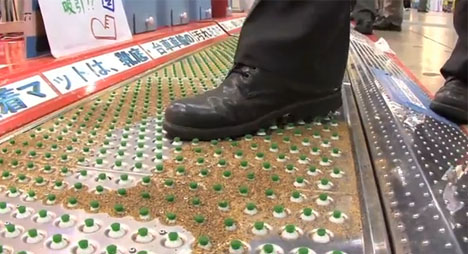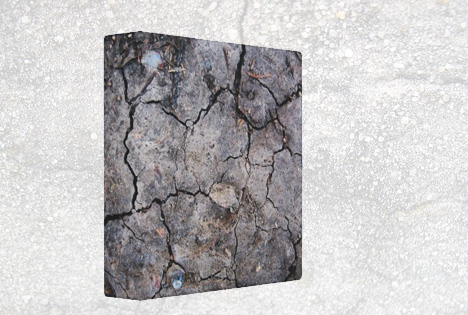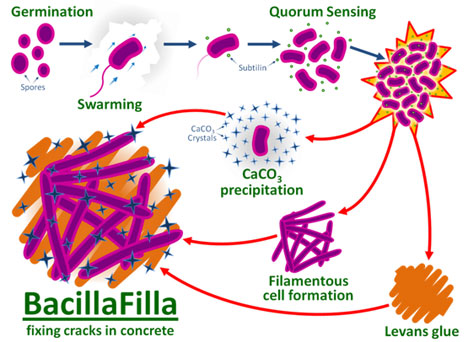Designed by Alex Killeavy, these loudspeakers are built for
sustainability both for entertainment and for the environment as well.
Using recycled glass the designer has created user friendly woofers and
tweeter components which are replaceable. The design is sophisticated
and created with sound material choices to last a lifetime. Its
aesthetic design is pleasing for home decor as well.
Online Sample Room for Interior Materials and Finishes / Raffles International College Hong Kong
Friday, November 9, 2012
Decafé Lamp
Taking advantage of the renewable and biodegradable attributes of coffee, Spanish designer Raúl Laurí created an innovative, experimental and very cute lamp. Dubbed the Decafé Lamp, it is made from a new composite material made from recycled coffee grounds. Shaped like a cup, this comforting, aromatic luminaire has a switchless design – to turn it on simply pick it up and place it on its base.
The Decafé Lamp recently took first place in this year’s Salone Satellite Awards during Milan Design Week
2012. The award was given in recognition for the design’s development,
research and experimentation with sustainable materials. Laurí’s
innovative recycled coffee material has great potential – we’d love to
see it turned into an entire range of caffeine-based products!
Thursday, November 8, 2012
Beer can house
Here I leave you a video explaining how to make the beer can house real. Comedian Jiff Hilliard interviews the owner of this particular house.
Gardening in tires
In this tire garden experiment we can see how many ways of recycling a tire we can use when designing a green area. Some of them look pretty easy to build.
Recycled cans
Being China the greatest beer consumer all around the world, how if we tried to used all those (now) empty cans to do our designs? A graduate of Bezalel Academy of Art and Design, Zinaburg, has proposed these three pieces of furniture:
As for the walls we can have solve the construction issues in many ways. Maybe by adding cement, maybe by cutting the cans into pieces, maybe by pilling them:
And this designer hasn't been the first one to come across this idea. Already in the 20's this designed was proposed:
Even the can opener can be a source of inspiration when designing a lamp, such as this piece called "Techno Pop", by the Brazilian designer Maurizio Affonso (through Decoratrix):
Recycled tires
How about if we decide to approach design by using only one material to the concept. We can make numerous things out of tires. For example the Korean designer Yong Ho Jin designed a collection of animal sculptures. Another artist, Wim Delvoye, did this detailed carving:
Also by adding a structure we can design seating places or tables. Some soft surfaces such as cushions may be added in order to make them comfortable:
Also by adding a structure we can design seating places or tables. Some soft surfaces such as cushions may be added in order to make them comfortable:
We can also knit the tires, or cut them into peaces to make a hairy look finish for our couch:
How about manufactuing the tire and producing a clean material that is perfectly water proof and can be used as a sink?:
Tires have the property of being very strong and can easily turned into a massive material by filling it with concrete or cement. So also walls can be made out of tires, just by pilling them and adding a substance that works as an adherent.
As for the flooring there are companies that recycle tires and have already industrialized the process, such as the Recycled Rubber Tire Tile by Recycled Rubber Floors.
Tuesday, November 6, 2012
Save our nature while taking shower
RUSHES AND REEDS COULD RECYCLE YOUR SHOWER WATER NATURALLY
I have this idea of using the plants in the bathroom to represent my sustainable material. People wasted a lot of water while they were taking shower, water just flow back into the filthy drain. So why not we just plant the plants inside the bathroom in order to save our water. I'm so glad that this kind of bathroom really does exist. Designers, Jun Yasumoto, Vincent Vandenbrouk, Olivier Pigasse and Alban Le Henry came out this idea few years ago and they brought this idea into our bathroom. If you the kind of guy always forget to water your plants, now here you go!
Sustainable design is something new to our species; homo sapiens, but plants like reeds and rushes learned the basics of it millions (or even billions) of years ago.
Now designers Jun Yasumoto, Vincent Vandenbrouk, Olivier Pigasse, and Alban Le Henry invite natures experts into your shower to recycle your water sustainably.
After you have washed in this shower the water passes down into filters and is treated by the reeds and rushes growing around your feet. This cleans the shower water naturally. As Jun Yasumoto puts it:
“These plants have been proven to be able to remove the chemicals from your shampoo. Using a natural filtering principle called phyto-purification, the bathroom becomes a mini-eco-system by recycling and regenerating the waste water. With this project, we tried to combine the pleasure of taking a shower with the satisfaction of recycling water. We wanted the recycling process to actually interact with the use of shower.”
As you see in the diagram after the jump, you would stand on a platform and the reeds would only grow around the sides comprising the “walls” of the shower. You don’t have to share your standing room with the plants!
The waste water would pass into a chamber below the shower floor and go through a maze of filters. The system includes sand, reeds, rushes, a mesh filter, water hyacinths and lemnas, and finally a carbon filter.
The waste water would pass into a chamber below the shower floor and go through a maze of filters. The system includes sand, reeds, rushes, a mesh filter, water hyacinths and lemnas, and finally a carbon filter.
They actually conceived of their idea seven years ago. It was only after posting the concept on the internet recently that they realized that the level of interest warranted another look at their concept. They have been inundated with queries about where their shower can be bought.
“No prototype has been made as the project is just a concept for the moment, but it is interesting to see the positive feedback we are getting since we put these images online,”Yasumoto said “It has made us think we should keep on developing this idea and start thinking of ways to integrate it and bring it closer to reality.”
Perhaps it is time for a patent and commercialization of the idea. Kudos go to these graduates from the French national design school Ecole Nationale Supirieure de Creation Industrielle.
Wednesday, October 31, 2012
IdeaPaint
Chalkboard wall paint has been around for a while now, but dealing with chalk dust gets old fast - the solution, of course, is to upgrade that paint just as schools have updated their own writable teaching surfaces.
 Young 20-something entrepreneur John Goscha dropped out of his banking job to design and market this material "for home, work or school" that may transform walls as we know now them. It is called IdeaPaint. It is available for half the price of an actual whiteboard and works just as well or better, leaving no marks behind when you wash down your work (and, without the rest of the infrastructure, it turns out to be greener, too). Here's a video showing you how to install IdealPaint.
Young 20-something entrepreneur John Goscha dropped out of his banking job to design and market this material "for home, work or school" that may transform walls as we know now them. It is called IdeaPaint. It is available for half the price of an actual whiteboard and works just as well or better, leaving no marks behind when you wash down your work (and, without the rest of the infrastructure, it turns out to be greener, too). Here's a video showing you how to install IdealPaint. Here are some of the interiors where the paint were used. It is an awesome idea especially if you have kids at home who just LOVE to mess with your wall.
Labels:
chalkboard,
Division 9 Finishes,
home,
IdealPaint,
kids,
paint,
school,
wall,
wallpaint,
writing
Dance Floor Power!
Club Surya opened its doors in London in 2008 making it Britain’s first
eco friendly nightclub. The club itself is built of recycled materials,
but the dance floor is the best piece. Using piezoelectricity technology, a way of converting the kinetic energy of the dance into
electricity, it produces enough electricity to power sixty percent of
the entire club.
The brainchild of 39-year-old property developer Andrew Charalambous, aka Dr. Earth, Surya has its own wind turbine and solar energy system, with the plan to donate any surplus electricity to local residents.
When clubbers need a rest from strutting their stuff on the dance floor they can relieve themselves at the latest air flush, waterless urinals and low flush toilets as well as taking the opportunity to freshen up with the club's automatic taps.
If Princes Harry and William and their aristocratic friends, who are frequently spotted at hot London nightclubs such as Boujis or Mahiki, want to attend Surya they will have to sign a pledge to work towards curbing climate change like all patrons attending the club in north London.
"Unless we stop preaching to people and use an inclusive philosophy we're never going to create the revolution to combat climate change," Charalambous told Reuters, explaining why he has invested one million pounds in the club.
"It's also about creating avenues of thought. Imagine what you could achieve if big corporations adopted this kind of initiative."
The technology used in this flooring can be used in just about anything. There’s even plans to fit it into clothing so people can generate electricity by moving which will be able to power mobile electrical devices.
The brainchild of 39-year-old property developer Andrew Charalambous, aka Dr. Earth, Surya has its own wind turbine and solar energy system, with the plan to donate any surplus electricity to local residents.
When clubbers need a rest from strutting their stuff on the dance floor they can relieve themselves at the latest air flush, waterless urinals and low flush toilets as well as taking the opportunity to freshen up with the club's automatic taps.
If Princes Harry and William and their aristocratic friends, who are frequently spotted at hot London nightclubs such as Boujis or Mahiki, want to attend Surya they will have to sign a pledge to work towards curbing climate change like all patrons attending the club in north London.
"Unless we stop preaching to people and use an inclusive philosophy we're never going to create the revolution to combat climate change," Charalambous told Reuters, explaining why he has invested one million pounds in the club.
"It's also about creating avenues of thought. Imagine what you could achieve if big corporations adopted this kind of initiative."
The technology used in this flooring can be used in just about anything. There’s even plans to fit it into clothing so people can generate electricity by moving which will be able to power mobile electrical devices.
Transition Metal Switchable Mirror
The switchable-mirrors technology was developed by Tom Richardson and Jonathan Slack of Berkeley Lab's Environmental Energy Technologies Division. By using transition metals rather than the rare earth metals used in the first metal-hydride switchable mirrors, Richardson and Slack were able to lower the cost and simplify the manufacturing process. Energy performance is improved as well, because the new windows can reflect or transmit both visible and infrared light. Besides windows for offices and homes, possible applications include automobile sunroofs, signs and displays, aircraft windows, and spacecraft.
Vacuum Floor Mat Cleans Your Shoes
Viz Gizmodo: “The mat was developed by Paionia Furyokuki and its surface is perforated with valves that are only opened as they’re stepped on. So as someone walks across the mat, it activates what are essentially a series of little vacuums that suck the dirt and debris off the sole of the shoe, and then into an external unit where it can be later disposed of”
Now, to be fair, these are probably a great idea for high-traffic industrial spaces that are hard to keep clean, or for someone with a passion, say, for fixing and cleaning cars in their garage. And who knows: maybe with time the technology will become cheaper, and these will replace everyday mud mats in the modern home.
Tuesday, October 30, 2012
Solar Bottle Lamps: Water + Bleach = 10,000 Liters of Light
electricity.
The physics of the concept are straightforward: the bottles are placed in roofs – half outside, half inside – and their lower portions refract light like 60-Watt light bulb but without the need for a power source. A few drops of bleach serve to keep the water clear, clean and germ-free for years to come.
We take for granted our electric lights, windows and skylights to access the sun’s glow, but for those living in close-together shacks with corrugated-metal roofs, a stray ray is welcome, and something that can spread light to the darkest interior corners can be a dream come true.
Curing Concrete: Engineered Bacteria Naturally Heals Cracks
Imagine buildings that never need to be repaired, streets that heal their own cracks, and sidewalks that morph back into perfect condition after buckling and breaking. A smart bacteria might usher in all of those things and more by helping concrete seal on its own after cracking up.
The self-healing concrete would be particularly useful in places where earthquakes are common and tend to create structural damage that has historically proven very difficult to repair. Rather than razing the buildings as in the past, we could continue to use them as the damage is quickly and easily repaired. Worried about crazy concrete-secreting bacteria taking over and paving the planet? Have no fear: the bacteria would have built-in safety measures that would allow them to work their magic only in structural cracks and would cause them to self-destruct if they ventured outside of the intended target.
Another way of self-healing concrete is developed by Delft University of Technology. They developed asphalt pavements:
The bitumen bonds can be repaired once and again, for several times, by making asphalt electrically conductive. Because asphalt concrete is not an electrically conductive material, steel wool fibers have been added. These are connected inside the asphalt concrete and create small circuits. When this new type of asphalt is heated with induction energy, the bitumen melts and that holds the road together. |
Magic Glass
Watch this video first, it would inspire you on various ways you can use the "Magic Glass" (or Smart Glass).
Sandwiched between two outer layers of conventional glazing sits a liquid crystal polymer membrane that can be activated by remote control or turned on (opaque) and off (see through) via conventional light switches.
Such shifts in opacity mean the same surface can serve as a window,
partition, privacy screen or projection surface. Prefabricated with the
synthetic core in place, units can be safely brought to and installed on
residential or commercial building sites with ease.
Vintage Leather Belts
(Belt) strapped for cash? Forget affordable for a minute and just imagine the curious combination of feeling aged leather beneath your feet and the look of vintage belts lining the floors of your home. Leather flooring is fairly unusual, but these upcycled belt designs are unique – each one hand-crafted and with individually-selected old belts.
BranchHome gives you Vintage Belt Floor Mat which are handsome, handmade floor mat is made of artfully assembled vintage leather belts that have been rescued on their way from waist to waste. Its rich tones, textures, and tread-friendly patina evoke the look of a wonderfully worn wood floor, albeit with a decidedly warmer under-foot feel. And the price? Over 600 US dollars for the round mat shown below:
Other ideas - Benches and chairs:
Further reading: Old Belts? Create Some Interesting Pieces of Furniture!
Thursday, October 25, 2012
Paper Knitting!
As part of sustainable materials research, today in class we did some real models with paper. Among other solutions, we developed a prototype of fabric made out of paper by knitting newspapers. Here I leave you some pictures of the process:
The neverending world of the Recycled Paper
There are tons of ways of using Recycled Paper as a material. If we think about how to reuse paper when designing pieces of furniture, then we can look at existing examples such as the one designed by Artists for Humanity in Boston. This table is covered with an ecofriendly resin that protects it from the water
Table by Artists for Humanity
We have also found many designers knitting the paper such as if they were using wicker. After knitting it we need to put a final coat to protect it. The artist Movana Chen desgined a piece called Body Containers where she made clothes out of knitted paper.
And then last, but not least, I wanted to bring Hong Kong Eureka Interior Design Office proposal for the bike shop Spread by Gum.
The space is also used as a socializing area, and therefore, the client asked it to be versatile. So Eureka designers came with a paper roll wall that can be pulled in and out depending on the needs. 5412 recycled paper tubes of 38.5 mm Ø were used to create this display.
Technical Information about this project:
Location: Tsim Sha Tsui, Hong Kong
Type: retail shop
Year: 2011
Area: 35m2
Cost: HKD180,000
Subscribe to:
Comments (Atom)








































.JPG)







